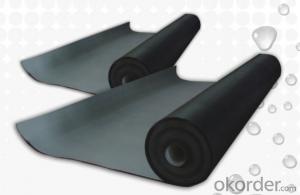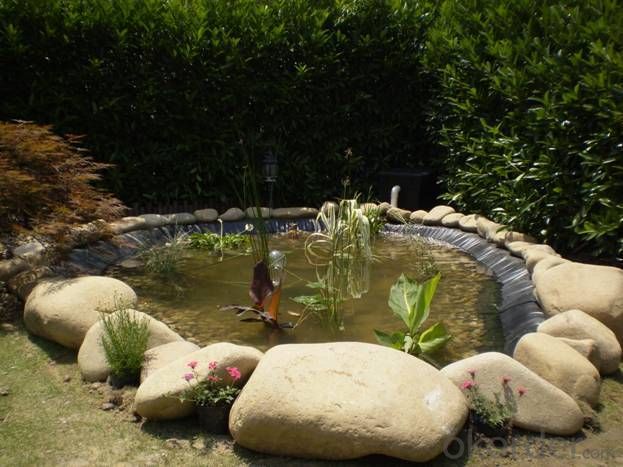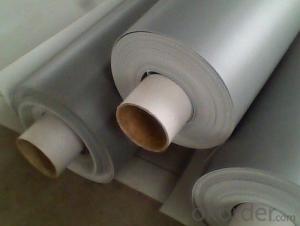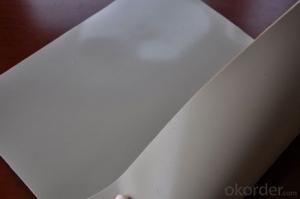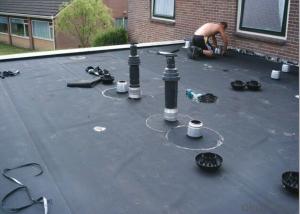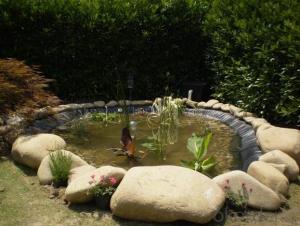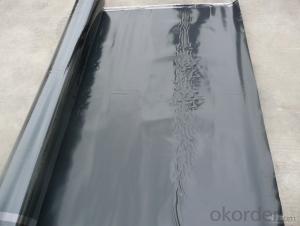EPDM Rubber Material Waterproof Membrane for Topping
- Loading Port:
- Shanghai
- Payment Terms:
- TT OR LC
- Min Order Qty:
- 50000 m²
- Supply Capability:
- 5000000 m²/month
OKorder Service Pledge
OKorder Financial Service
You Might Also Like
EPDM Rubber Material Waterproof Membrane for Topping
Description Of EPDM Rubber Material Waterproof Membrane for Topping:
This waterproof coiled material is of high elasticity with best performance among high polumer waterproof coiled material in the world.It is also the most typical one in the world.Waterproof coiled material made of ternary ethylene-propylene rubber is produced with the use of the most advanced contiuous extrusion and vulcanization technology and related equipments which are specially designed for production of such product.It is good in compactness,without bubble and performance difference in length and breadth,perfomances reach or exceed the demands of GB18173.1-2000 standard.
Main Features of EPDM Rubber Material Waterproof Membrane for Topping:
1.EPDM waterproof membrane for bridge engineering waterproof
2.EPDM waterproof membrane for water conservancy projects ,such as river bank,lake dam seepage.
3.EPDM waterproof membrane for the municipal engineering.
4.EPDM waterproof membrane for aquaculture.
Specifications of EPDM Rubber Material Waterproof Membrane for Topping:
| Number | Item | Unit | Value | |
| 1 | Size Variation | Thichness | % | ±10 |
| Width | % | ±1 | ||
| Length | % | Allowed negative | ||
| 2 | Breaking tensile strength at normal temperature | Mpa | ≥7.5 | |
| Breaking tensile strength at 70°C | Mpa | ≥2.3 | ||
| 3 | Breaking elongation at normal temperature | % | ≥450 | |
| Breaking elongation at -20°C | % | ≥200 | ||
| 4 | Tear strength | KN/m | ≥25 | |
| 5 | Impermeability(30min) | * | 0.3Mpa no leakage | |
| 6 | Bending at low tempreture | °C | ≤-40 | |
| 7 | Stretch tensor at heating | Elongate | mm | ≤2 |
| Shrink | mm | ≤4 | ||
| 8 | Air oven aging(80°C×168h) | Tensile strength at break retained | % | ≥80 |
| Elongation at break retained | % | ≥70 | ||
| 9 | Anti-alkali | Tensile strength at break retained | % | ≥80 |
| Elongation at break retained | % | ≥80 | ||
| 10 | Nuture weathing at manual simulation | Tensile strength at break retained | % | ≥80 |
| Elongation at break retained | % | ≥70 | ||
Applications of EPDM Rubber Material Waterproof Membrane for Topping:
Widely used in roofs, basement, toilet ,swimming pool, and all kinds of industry and civil building waterproofing, reservoir, vivicism, bridge, underground, tunnel and dam waterproofing ,especially to the keystone waterproofing projects which is durability, high corrosion resistance and easy deformation.



IMages of EPDM Rubber Material Waterproof Membrane for Topping:




FAQ of EPDM Rubber Material Waterproof Membrane for Topping:
1. What are we supplying?
We are specialized in producing Colorful Asphalt Roof Shingle, SBS/APP modified bitumen waterproof membrane, Self adhesive bitumen waterproof membrane, PVC waterproofing membrane, EPDM rubber roofing membrane, Single Component Polyurethane Waterproof Coating, and Spray Polyurea Waterproof Coating
.
2. How Many years experience do we have?
We have been exported to more than 20 countries in the past 15 years.
3. How long do we usually reply your request?
We always reply our customer within 24 hours.
- Q: Does a waterproofing membrane require any curing time before it can be exposed to water?
- Before being exposed to water, a waterproofing membrane does require a curing time. This curing time is necessary for the membrane to fully bond and reach its maximum strength, durability, and waterproofing capabilities. The specific duration of the curing time may vary depending on the type of membrane and the instructions provided by the manufacturer. To ensure proper curing and effective protection against water intrusion, it is crucial to adhere to these instructions. Neglecting to allow sufficient curing time can compromise the membrane's effectiveness, potentially resulting in leaks or other related issues. Therefore, it is highly recommended to wait until the specified curing time has passed before exposing the waterproofing membrane to water.
- Q: Are there any specific installation requirements for waterproofing membranes?
- Yes, there are specific installation requirements for waterproofing membranes. These requirements may vary depending on the type of membrane being used, but there are some general guidelines that apply to most installations. Firstly, it is important to properly prepare the surface that the membrane will be applied to. This may involve cleaning the surface, removing any loose debris or previous coatings, and ensuring the surface is smooth and free from any irregularities. This step is crucial as it allows for better adhesion between the membrane and the surface. Next, the membrane should be applied according to the manufacturer's instructions. This typically involves using a suitable adhesive or bonding agent to adhere the membrane to the surface. It is important to follow the recommended application rate and ensure that the membrane is applied evenly and without any air bubbles or wrinkles. In addition to proper application, it is also important to pay attention to the seams and joints of the membrane. These areas are particularly vulnerable to water penetration, so they should be carefully sealed using an appropriate sealant or tape. This ensures a watertight seal and prevents any water from seeping through the seams. Lastly, it is important to protect the installed membrane from any damage during and after installation. This may involve covering the membrane with a protective layer, such as a geotextile fabric or a layer of soil, to prevent punctures or tears. Additionally, any construction or landscaping work that may occur after the installation should be done with caution to avoid damaging the membrane. Overall, the specific installation requirements for waterproofing membranes will depend on the type of membrane being used and the specific conditions of the project. It is always recommended to consult the manufacturer's instructions and guidelines to ensure proper installation and long-lasting waterproofing performance.
- Q: Is a waterproofing membrane resistant to impact damage?
- No, a waterproofing membrane is not typically resistant to impact damage.
- Q: Can waterproofing membranes be used on outdoor fountains?
- Yes, waterproofing membranes can be used on outdoor fountains. Waterproofing membranes are designed to create a barrier that prevents water from penetrating through surfaces, making them ideal for protecting outdoor fountains from water damage. These membranes are typically made of materials such as rubber, PVC, or bitumen, which are highly resistant to water and can effectively seal the fountain's structure. Applying a waterproofing membrane to an outdoor fountain can help prolong its lifespan, prevent leaks, and protect it from the elements.
- Q: Are waterproofing membranes resistant to chemicals?
- Yes, waterproofing membranes are generally resistant to chemicals. They are designed to provide a barrier against water, moisture, and various chemicals, making them highly effective in protecting surfaces against chemical damage.
- Q: What are the proper installation techniques for a waterproofing membrane?
- Proper installation techniques for a waterproofing membrane involve a series of steps to ensure effective and long-lasting protection against water infiltration. 1. Surface preparation: It is crucial to start with a clean and smooth substrate. Remove any loose debris, dirt, or previous coatings. Repair any cracks or imperfections in the surface before proceeding. 2. Primer application: Apply a suitable primer to enhance adhesion between the substrate and the waterproofing membrane. The primer should be compatible with both the substrate material and the membrane. 3. Membrane selection: Choose a waterproofing membrane that is appropriate for the specific application and site conditions. There are various types of membranes available, including sheet membranes, liquid-applied membranes, and self-adhesive membranes. Consider factors such as the substrate material, expected movement or stress, and exposure to chemicals or UV radiation. 4. Membrane installation: The exact installation method may vary depending on the type of membrane used, but the following general steps apply to most installations: a. Unroll or unfold the membrane carefully, avoiding any wrinkles or folds. b. Position the membrane onto the primed surface, ensuring it extends beyond the desired waterproofed area. c. Use a roller or trowel to firmly press the membrane onto the substrate, ensuring good contact and removing any air pockets. d. Overlap the edges of adjacent membrane sheets or sections according to the manufacturer's instructions, typically around 2-3 inches. e. Apply a suitable seam or joint adhesive to seal the overlaps securely. 5. Testing and inspection: After installation, it is essential to perform a comprehensive quality control check. Conduct a flood or water test to ensure the membrane effectively repels water and there are no leaks or defects. 6. Protection and finishing: Protect the installed membrane from damage during construction activities, and apply any necessary protection layers or coatings to enhance its durability and resistance to UV radiation or mechanical stress. 7. Maintenance and repair: Regularly inspect the waterproofing membrane and promptly address any signs of damage, wear, or deterioration. Follow the manufacturer's guidelines for maintenance and perform necessary repairs as soon as possible to maintain the membrane's effectiveness. Remember, it is always advisable to consult with a professional waterproofing contractor or follow manufacturer recommendations for the specific membrane being used, as installation techniques can vary.
- Q: Roof SBS waterproofing membrane can not empty shop
- Whether the waterproofing membrane is empty is determined by two aspects. 1, the construction site requirements. Such as the basement of the bottom of the membrane waterproof specifications require empty shop; deformation of the steel roof can be a small amount of sticky open shop or shop shop to adapt to structural deformation, but the coil to have a certain pressure.
- Q: Can a waterproofing membrane be used in elevator pits or sump pits?
- Yes, a waterproofing membrane can be used in elevator pits or sump pits. Elevator pits and sump pits are prone to water infiltration, and a waterproofing membrane can effectively prevent water from seeping into these areas. The membrane acts as a barrier, preventing any water from entering the pit and causing damage to the elevator or pumping system. This helps to maintain the integrity of the elevator or pump and prolong its lifespan. Additionally, a waterproofing membrane can also protect the surrounding structures and prevent any water damage. It is important to select a suitable waterproofing membrane that is designed for below-ground applications and has the necessary properties to withstand the specific conditions in an elevator or sump pit.
- Q: Can waterproofing membranes be used on below-grade parking structures?
- Below-grade parking structures can benefit greatly from the use of waterproofing membranes. They are frequently employed to safeguard these structures against water infiltration and potential harm. The main purpose of these membranes is to create a barrier that prevents water from penetrating the concrete and causing deterioration. To ensure the long-term durability and structural integrity of parking structures, the application of these membranes to the below-grade walls and floors is essential. Moreover, the use of waterproofing membranes also aids in the prevention of mold and mildew formation, which is a common problem in damp environments like below-grade parking structures. In conclusion, it is highly advisable to utilize waterproofing membranes in order to shield below-grade parking structures from water damage and prolong their lifespan.
- Q: Can a waterproofing membrane be used in cold climates?
- Yes, a waterproofing membrane can be used in cold climates. In fact, many waterproofing membranes are specifically designed to withstand extreme temperatures, including freezing conditions. These membranes are engineered to remain flexible and durable even in cold environments, ensuring effective protection against water infiltration and damage.
Send your message to us
EPDM Rubber Material Waterproof Membrane for Topping
- Loading Port:
- Shanghai
- Payment Terms:
- TT OR LC
- Min Order Qty:
- 50000 m²
- Supply Capability:
- 5000000 m²/month
OKorder Service Pledge
OKorder Financial Service
Similar products
Hot products
Hot Searches
Related keywords
